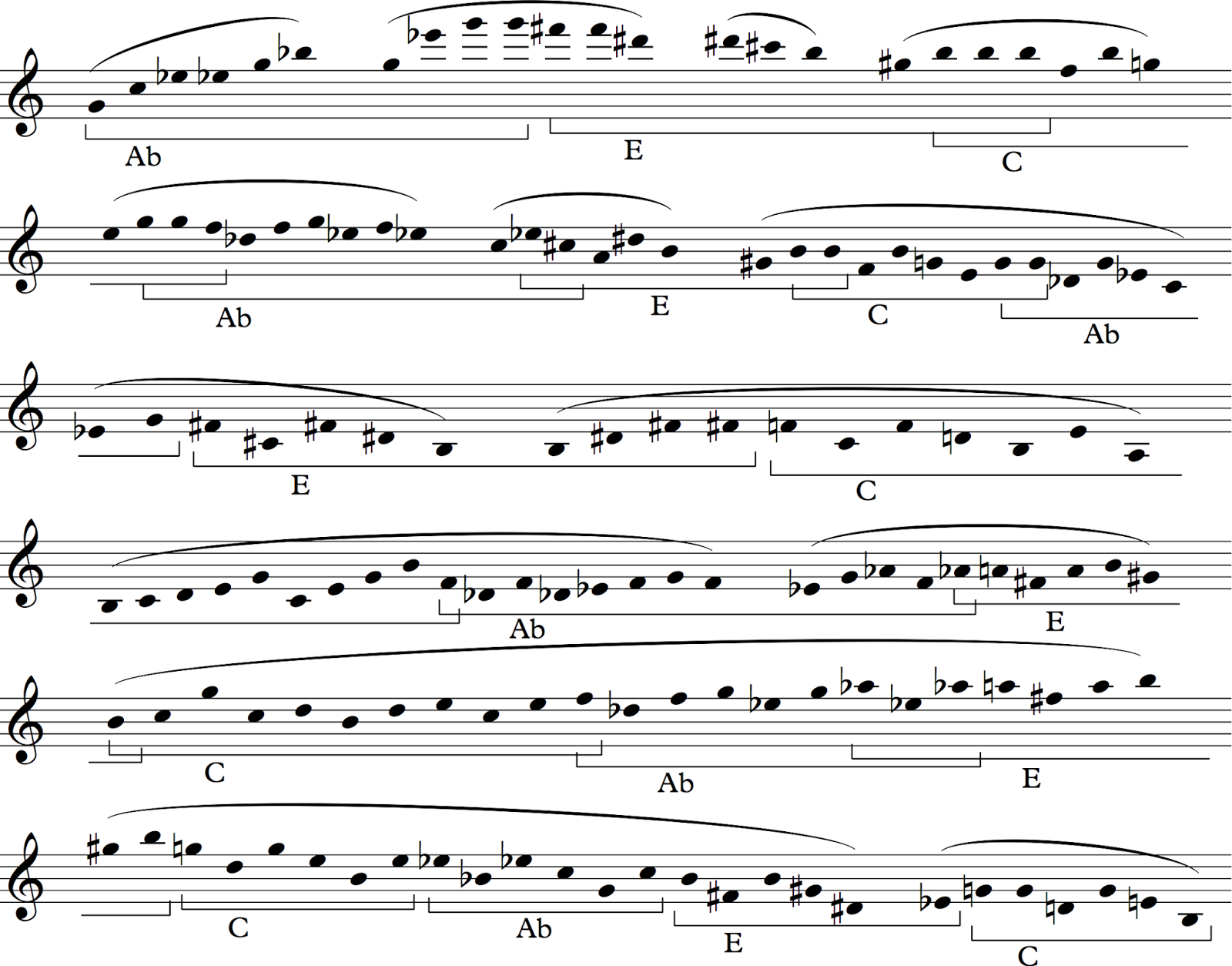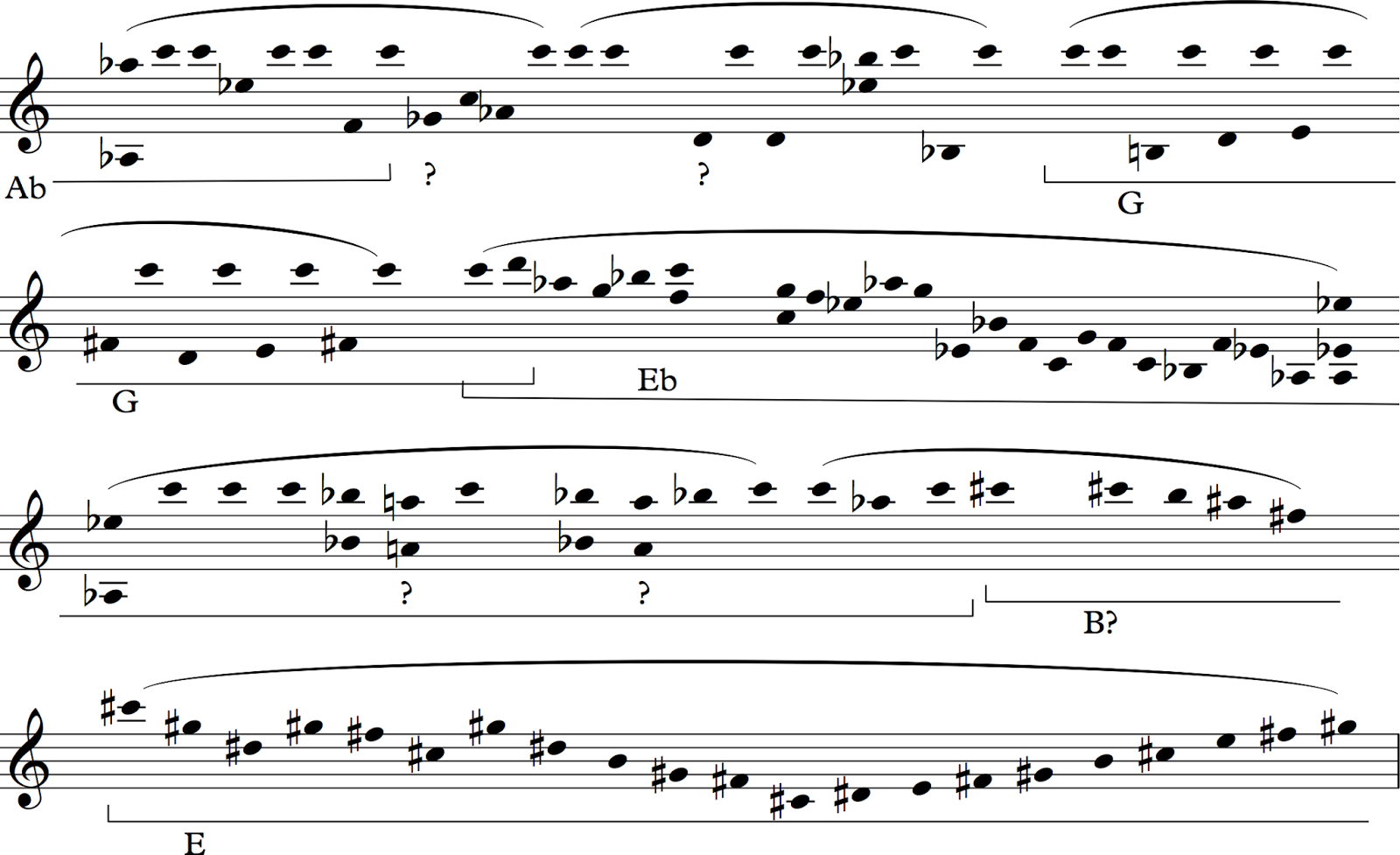Venus
Dan Voss
And for the heav'n's wide circuit, let it speak
The Maker's high magnificence, who built
So spacious, and his line stretched out so far;
That man may know he dwells not in his own;
An edifice too large for him to fill,
Lodged in a small partition, and the rest
Ordained for uses to his Lord best known.
John Coltrane's Interstellar Space is in my view a pinnacle of musical achievement. Each of its six pieces encompasses a galaxy of sonic meaning.
Lewis Porter's book John Coltrane: His Life and Music includes a transcription of Coltrane's saxophone playing on "Venus" (pages 283-7) as well as Porter's analytical overview of the piece. My own analysis alternately agrees and contrasts with Porter's. Since a thorough analytical treatment is not possible here, I offer instead a few comments.
"Venus" is, broadly speaking, tonal (not however in the Schenkerian sense of prolongation of a tonic triad) and teleological. The piece begins with the statement of a theme in the key of C; it leaves the tonic key and develops; and it returns to the initial theme in the tonic key of C.
Within that structure, "Venus" exhibits a cyclic harmonic form; namely, the major third interval cycle that is often associated with Coltrane. Specifically, the harmonic form of "Venus" comprises the diatonic collection with root transpositions of C, A♭, and E.
The cycle mostly descends (C-A♭-E) but also occasionally ascends (C-E-A♭). (See my previous discussion of harmonic tension in Coltrane cycles.)
A careful audition of "Venus" reveals that nearly everything that Coltrane plays is reducible to these three diatonic key centers.
As an example, take the initial departure from the C diatonic collection in line 7 of the transcription and 1:34 of the recording where major-third transpositions, smooth voice-leading, and harmonic gravitation combine in a microcosmic reflection of elements driving the piece as a whole. Here ♯^4 launches the transition away from the tonic, just as in common-practice music, approaching the dominant (G) via chromatically embellished lower and upper neighboring tones. These notes, though few, must nonetheless be heard in the context of the major third transpositions of the diatonic collection that, as I will show, so clearly dominate the piece. D♯/ E♭is the common tone pivot between the E and A♭diatonic collections represented here by four members each. Note that (F♯A E) and (E♭F A♭) are related by semitone transposition. (Below and throughout accidentals apply only to the note immediately following.)

Following standard jazz practice, Coltrane often melodically privileges the upper harmonic tones of the major diatonic collection — in particular the triad on the dominant. We must nevertheless be clear that Coltrane does not modulate to or tonicize the dominant — despite the frequent non-resolution of the leading tone (Coltrane's playing here, like most jazz, approaches pandiatonicism) — but remains in the key of one of the three major-third transpositions of the tonic. For example (lines 9-10, 1:45-1:56):

In some cases, Coltrane tonicizes key areas related by step to one of the three structural transpositions of the diatonic collection, C, A♭, and E. For example (page 3 line 1, 3:55-4:01):

Melodic contour and the leading-tone C♯ tonicize a D minor harmony, the ii chord of the underlying tonic key of C. In the following example, Coltrane similarly uses the leading-tone to tonicize F minor, the vi chord of A♭(page 2 line 10, 3:25).

We also hear C♯ minor treated likewise as the vi chord in E.
At 3:28 (page 2 lines 10-11), Coltrane manipulates what at first seems like a non-tonal pitch-class collection, (A B C D♯ F). We should notice however that this set contains the tritone axes from the keys of C (B-F) and E (A-D♯), as well as the tonic itself, (C).

By the time we hear the last phrase on the second staff above, it becomes clear that the apparently non-tonal set preceding it is in fact a form of the Phrygian II in the key of E (F7 or tritone substitution on the dominant) and thus firmly within the C-A♭-E cycle that governs the entire piece.
In certain instances what appear on paper to be departures from the governing harmonic cycle are simply gestural figures that remain audibly within the basic three-key framework; otherwise, chromatic embellishment and inflection of the overwhelmingly diatonic harmonies, as illustrated above. The music of "Venus" is at no point "atonal."
As an example of the pervasiveness of the C-A♭-E cycle, we can follow the higher-level semitone ascent that Porter points out on page 2, lines 1-10 of the transcription, or 2:16-3:25 on the recording. The upper-voice G, held over from the opening theme, climbs by half-steps and continuously receives structural support as a chord tone (whether third, sixth, seventh, ninth, etc.) over one of the three main-key roots. These implied roots are given in the lower clef in the illustration below.

Passages of higher-level ascent by step are a significant organizing factor in other pieces from Coltrane's later music, such as "Transition." Though Porter does not to show it in his analysis, the ascent depicted above continues for the entire following page of the transcription, or until 5:47 on the recording; the concluding fourth interval is spanned not by semitones but by diatonic steps.


As shown above, the harmonic cycle is maintained throughout — though the key centers indicated under the quickly stated altissimo F♯ and G are only weakly implied; furthermore, between 4:19 and 4:33 a clear digression from the cycle, indicated with brackets above, takes place. This will be addressed in detail below.
After this large-scale ascent, Coltrane releases accumulated tension with a passage of astonishing beauty. Here the music also adheres strictly to the three-key framework. The three common tones between any two of the transpositions of the diatonic collection allow for a smooth and intriguing melodic traversal. From 5:57-6:29:

In the entirety of "Venus" there are only a handful of ambiguous cases which cannot be fundamentally explained in terms of the C-A♭-E cycle. For example, in the course of the higher-level semitone ascent that Porter points out in his analysis, Coltrane seems to digress very briefly into a new harmonic area while prolonging a top-voice E♭/D♯ (3:09-3:14, page 2 line 8):

(The example above reinstates an overtone note that is missing from Porter's transcription.)
Is this a dissonance created by suggesting a transposition of the cycle by a half-step? Or, is this mostly a chromatic elaboration of B dominant seventh, and therefore well within the basic key cycle? (Melodically, the phrase labelled "B7" perhaps most strongly implies E minor. We hear apparent E minor figures throughout "Venus," but primarily in the context of the C diatonic collection — i.e., E phrygian.) This phrase is different enough to stand out (the intervals D-B♭ and D-F♯ are absent from all three recurring diatonic transpositions), but maybe not enough to qualify as a true departure from the fundamental harmony.
Another brief but less ambiguous departure from the three-key framework is during the "recapitulatory" statement of the theme. Coltrane quickly and repeatedly cascades down a C major scale, and at 7:36-7:41 (page 5 line 4) he lowers the third and seventh degrees by a semitone to give the C scale a minor shading before shifting back to major mode. This harkens to the C-A♭relationship heard throughout the piece, but the retention of D-natural excludes that categorization.
In fact, there is only one instance in which Coltrane substantially and unambiguously diverges from the C-A♭-E key cycle. It is perhaps not a coincidence that this occurs during one of the most dramatic passages in the piece, as Coltrane leaps rapidly between the upper and lower registers of the saxophone, nearly two octaves separating successive notes. We hear this episode between 4:19 and 4:33, as mentioned above, during the long higher-level stepwise ascent and as the upper-voice C and then C♯ are prolonged.

Coltrane first moves away from the home cycle key of A♭ by adding a G♭. We can perhaps think of the pitch collection on the first staff as E♭ melodic minor, or A♭7#11 (tritone substitution?), moving by the end of the staff to G. Or we can simply follow the common tones and dynamic tones — C, D, and G♭/F♯ held in common, B♭ and E♭ sliding to B and E.
As we see on the second staff above, the G collection is then transposed to E♭, facilitated again by three common tones. On the third staff A♭ moves to A-natural, abolishing the sound of the key of E♭. The three-note motive (A B♭ C) is sounded twice, and then transposed up a semitone to (A♯ B C♯), evidently suggesting another major-third transposition from Eb to the diatonic collection on B. As the phrase continues, however, we find that B is not maintained. The collection on E returns; it is then colored as an F♯ chord with a suspended fourth and lowered 2nd and 6th degrees, then followed by A♭ and a clear reinstatement of the basic cycle.
Ultimately, the listener is left with the impression that in this passage Coltrane has transposed the fundamental major-third cycle by a semitone, from (C-A♭-E) to (G-E♭-B), creating a structural harmonic dissonance that is underscored by the outstanding registral displacement that initially accompanies it.
The form of "Venus" can be broadly outlined as follows:
- Statement of the theme (:32-1:34)
- Initiation of development (1:34-2:16)
- Prolongation of stepwise ascent (2:16-5:47)
- Descent and release (5:47-6:29)
- Fragmentation; overtones and gestural note flurries (6:29-7:06)
- Return of the theme; "recapitulatory development" (7:06-8:16)
Despite its status as a paragon of "free jazz," it is clear that Coltrane's improvisation on "Venus" is thoroughly informed throughout by a harmonic cycle of specific major-third transpositions of the diatonic collection. I make no claim as to Coltrane's intent; but since the musical surface falls within the "scalar tradition," I believe that the analytical approach I offer here provides considerable utility.
Just as Charlie Parker's myriad improvisational manipulations of "I Got Rhythm" changes represent a greater artistic achievement than George Gershwin's in composing them, Coltrane's masterful artistry lies not in the application of the major-third cycle but in the ways in which he elaborates, varies, and obscures it.
In merging a teleological formal arc characteristic of Western classical music but absent from most jazz with a repetitive, cyclic form typical of jazz as well as many African and other folk and dance musics, Coltrane's "Venus" represents a truly rare musical breakthrough. While Interstellar Space hardly admits comparisons, the syncretic formal approach I point to in "Venus" in some sense parallels the rotational sonata form of Sibelius's Symphony No. 5.